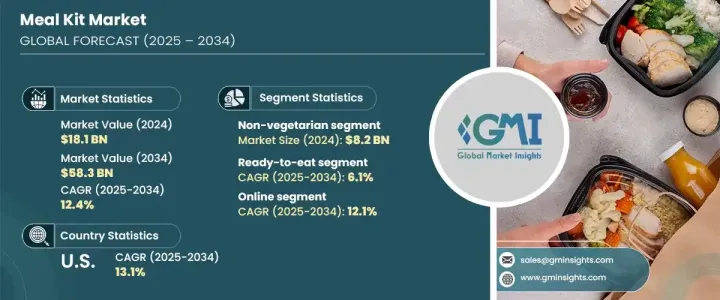
세계의 밀키트 시장은 2024년에는 181억 달러로 평가되었고, 2025년부터 2034년에 걸쳐 CAGR 12.4%를 나타낼 것으로 예측되어 대폭적인 성장을 이룰 것으로 예상됩니다.
이 성장의 원동력이 되고 있는 것은 품질이나 영양면에서 타협하지 않고, 시간을 절약할 수 있는 편리한 가정 요리를 요구하는 소비자의 기호의 진화입니다. 밀키트는 매력적인 솔루션을 제공하고 간단한 조리법과 함께 미리 분량 된 재료를 제공합니다.

기존의 식료품 쇼핑이나 식사 계획을 대체하는 번거로운 방법을 요구하는 소비자가 늘어남에 따라, 이러한 키트 수요는 계속 급증하고 있습니다. 밀키트는 다양한 식사 요구에 대응하고, 처음부터 요리하는 스트레스 없이 건강한 식생활을 요구하는 개인에게 매력적인 선택이 되고 있습니다. 이러한 편의성으로의 전환은 소비자들이 바쁜 라이프스타일에 맞는 시간 절약 상품을 더욱 중요시하고 있다는 보다 넓은 사회 동향을 반영합니다. 밀키트 딜리버리 서비스의 시작은 사람들의 가정 요리에 대한 접근 방식을 재구성하고 매일 식사를 만드는 데 사용할 수있는 현대적인 솔루션을 제공합니다.
| 시장 범위 | |
|---|---|
| 시작 연도 | 2024년 |
| 예측 연도 | 2025-2034년 |
| 시작 금액 | 181억 달러 |
| 예측 금액 | 583억 달러 |
| CAGR | 12.4% |
2024년 밀키트 시장에서 비채식 분야 시장 규모는 82억 달러였고, 2025년부터 2034년까지의 CAGR 성장률은 12.3%를 나타낼 것으로 예측됩니다. 고기와 해산물은 많은 식생활에 빠뜨릴 수 없는 요소이기 때문에 비 채식주의자 밀키트는 폭넓은 소구력에 의해 특히 인기를 모으고 있습니다. 이 밀키트는 단백질이 풍부한 옵션을 요구하는 소비자에게 특히 지지되어 있으며, 건강과 피트니스를 중시하는 소비자와 특정 식단 기호를 따르는 소비자에게 이상적인 선택입니다. 고기와 해산물을 기반으로 하는 밀키트 수요가 증가하는 가운데, 각사는 보다 폭넓은 식사 메뉴를 갖추고, 고객이 버라이어티가 풍부한 편리한 식사를 즐길 수 있도록, 상품 라인업을 확충하고 있습니다.
밀키트 시장에서 조리된 식품 부문은 2024년 30억 달러에 이르렀으며 2034년까지 연평균 복합 성장률(CAGR) 성장률은 6.1%를 나타낼 것으로 전망됩니다. 소비자의 삶의 속도가 점점 빨라짐에 따라, 편리하고 요리가 불필요한 식사에 대한 요구가 두드러지고 있습니다. 포장된 샐러드나 전자레인지로 따뜻하게 하는 식사 등 곧바로 먹을 수 있는 밀키트는 편리함을 우선하는 바쁜 스케줄을 가진 개인들 사이에서 인기가 높아지고 있습니다. 이 다이어트는 영양면에서 타협하지 않고 간단하고 신속한 솔루션을 제공하기 때문에 매일 루틴에 최소한의 노력과 최대 효율을 요구하는 소비자에게 매력적인 선택입니다.
미국의 밀키트 시장은 2024년에 59억 달러를 창출했고 2034년까지 13.1%의 연평균 복합 성장률(CAGR)을 나타내 경이적인 성장을 이룰 것으로 예상됩니다. 도시화는 이 성장의 주요 요인이며, 많은 도시 지역의 직업과 가족이 시간 절약 옵션으로 밀키트를 선택합니다. 긴 통근 시간이나 가혹한 근무 스케줄에 의해 가정 요리가 실현하기 어려운 도시에서는 밀 킷이 실용적인 해결책이 되고 있습니다. 게다가 스마트폰과 인터넷이 널리 보급됨에 따라 주문 및 배달 프로세스가 쉬워지고 이러한 서비스에 대한 액세스가 향상되었습니다. 그 결과, 밀키트의 소비량은 증가의 일도를 따르고 있어 편리하고 건강한 식사를 요구하는 미국의 가정이 증가하고 있습니다.
The Global Meal Kit Market was valued at USD 18.1 billion in 2024 and is set to experience substantial growth, projected to expand at a CAGR of 12.4% from 2025 to 2034. This growth is driven by evolving consumer preferences for convenient, home-cooked meals that save time without compromising on quality or nutrition. Meal kits offer an attractive solution, delivering pre-portioned ingredients alongside easy-to-follow recipes.

As more consumers seek hassle-free alternatives to traditional grocery shopping and meal planning, the demand for these kits continues to surge. Meal kits cater to various dietary needs, making them an appealing choice for individuals seeking to eat healthier without the stress of cooking from scratch. This shift toward convenience reflects broader societal trends, with consumers placing greater importance on time-saving products that fit into their busy lifestyles. The rise of meal kit delivery services has reshaped the way people approach home cooking, offering an accessible and modern solution to daily meal preparation.
| Market Scope | |
|---|---|
| Start Year | 2024 |
| Forecast Year | 2025-2034 |
| Start Value | $18.1 Billion |
| Forecast Value | $58.3 Billion |
| CAGR | 12.4% |
The non-vegetarian segment in the meal kit market was valued at USD 8.2 billion in 2024, with projections showing a growth rate of 12.3% CAGR from 2025 to 2034. Non-vegetarian meal kits have become especially popular due to their wide appeal, as meat and seafood are essential components of many diets. These meal kits are particularly favored by individuals seeking protein-rich options, making them an ideal choice for consumers focused on health and fitness or those following specific dietary preferences. With the demand for meat and seafood-based meal kits on the rise, companies are expanding their offerings to include a broader range of meal options, allowing customers to enjoy variety and convenience in their meals.
The ready-to-eat segment within the meal kit market reached USD 3 billion in 2024, with a growth rate of 6.1% CAGR through 2034. As consumers' lives grow increasingly fast-paced, the need for convenient, no-prep meals is more pronounced. Ready-to-eat meal kits, such as pre-packaged salads and microwaveable meals, are becoming increasingly popular among individuals with busy schedules who prioritize convenience. These meals offer a simple, quick solution without compromising on nutrition, making them an attractive option for consumers who seek minimal effort and maximum efficiency in their daily routines.
In the U.S., the meal kit market generated USD 5.9 billion in 2024 and is expected to grow at an impressive 13.1% CAGR until 2034. Urbanization is a key factor behind this growth, with many urban professionals and families opting for meal kits as a time-saving alternative. In cities where long commutes and demanding work schedules make home-cooked meals less feasible, meal kits have become a practical solution. Furthermore, the widespread use of smartphones and the Internet has facilitated the ordering and delivery process, enhancing the accessibility of these services. As a result, meal kit consumption continues to rise, with more American households seeking out convenient, healthy meal solutions.